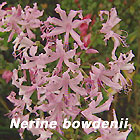These elegant, South African natives are amongst Peter Valder’s favourite bulbs. They are hardy, easy to grow and they add a splash of colour to otherwise drab, autumn gardens. Peter particularly likes the white Nerine flexuosa ‘Alba’, but there are many other kinds available.
Growing nerines
Nerines should be planted in summer when they are dormant. They like a well-drained, sunny position. Plant the bulbs about 10cm (4″) apart, with the neck of the bulb above the soil. They also do very well planted in pots, and can be brought inside the house when in flower.
Water well during the growing season, but allow them to dry out during the dormant period. Feed occasionally with liquid fertiliser.
Nerine bulbs do not like to be disturbed. Do not lift and divide the clump unless the bulbs are so overcrowded that they are not producing many flowers.
Nerines like a cool to temperate climate.
Nerines shown in our segment:
Nerine bowdenii:
A strong, vigorous nerine that is very easy to grow. Clusters of pink flowers with reflexed petals and frilly tips are produced in autumn. The strap-shaped leaves do not appear until spring, then die off to make way for more flowers the following autumn. Because its leaves are largely absent during winter, it can withstand lower temperatures than most nerines. There are several colour forms available.
Nerine flexuosa
‘Alba’: A beautiful white-flowered nerine. Clusters of up to 15 flowers with narrow, reflexed petals are produced on stems to 60cm (24″) tall. It is a little more difficult to grow than other nerines. The leaves appear at the same time as the flowers and can be damaged if the climate is too cold, but if it’s too hot the plant won’t flower. Most nerines need full sun to grow and flower well, but ‘Alba’ will flower in shade.
Nerine fothergillii var. major:
The large tangerine flowers of this nerine have a golden sheen on each petal. They appear in autumn on 60cm (24″) tall stems.
Nerine sarniensis:
This plant occurs naturally in the mountains of the Cape Province in South Africa. The flowers are bright red, with reflexed petals and prominent stamens. The strap-like leaves appear after flowering. This nerine is sometimes called the Guernsey lily, because in the seventeenth century bulbs from a shipwreck are said to have washed up and naturalised on the English Channel island of Guernsey.
Getting started
Nerines can be obtained by dividing a friend’s clump, or by mail order from specialist bulb nurseries such as the ones listed below. They cost $2.50-$4.00.
VIC
Blue Dandenongs Bulb Farm
Old Emerald Road, Monbulk, Vic, 3793
Phone: (03) 9756 6766, fax: (03) 9756 7844
Email: [email protected]
Website: www.blued.com.au
Bulb Express
470 Monbulk Road, Monbulk, Vic, 3793
Phone: 1800 677 437
Email: [email protected]
Website: www.bulbexpress.com.au
Tesselaar Bulbs and Flowers
357 Monbulk Road, Silvan, Vic, 3795
Phone: (03) 9737 9811. Fax: (03) 9737 9706
Email: [email protected]
Website: www.tesselaar.net.au/default.asp



